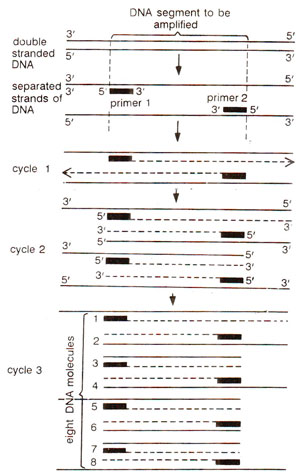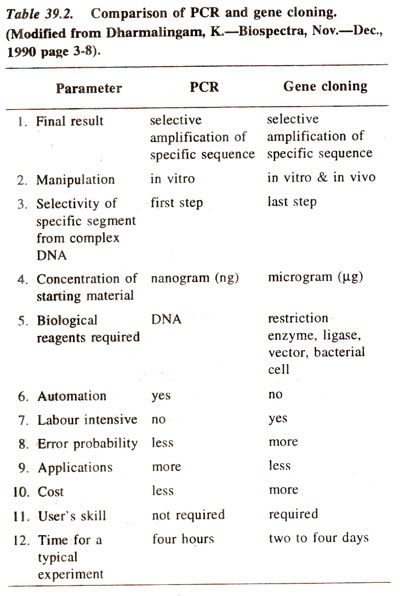
Fig. 39.20. Steps involved in basic polymerase chain reaction or PCR. (Modified and redrawn from Dharmalingam, K-Biospectra, Nov.-Dec, 1990 page 3-8).
In order to understand PCR, the readers should be familiar with the mechanism of DNA replication within the cells (consult
Chemistry of the Gene 2. Synthesis, Modification and Repair of DNA). The DNA replication involves polymerization of nucleotides using a template DNA strand with the help of an enzyme 'DNA polymerase' but this reaction invariably requires a primer strand to which further nucleotides can be added using the DNA polymerase enzyme. If the primer strand is not available the reaction can not proceed. In the living cells this primer strand is not a DNA strand but is a small single stranded RNA molecule synthesized with the help of RNA polymerase enzyme. In PCR, a similar reaction takes place in an Eppendorf tube, where the primer strand is added from outside in the form of a deoxyoligonucleotide and DNA polymerase enzyme is added to help in polymerization. Unlimited supply of amplified DNA is obtained by repeating the reaction, which is made possible by regular denaturation of freshly synthesized double stranded DNA molecules by heating it to 90-98
°C
. At this high temperature the two strands separate.
The denaturated DNA (at 90-98°C) and two primers, one recognizing each strand and bordering the sequence to be amplified are mixed. The mixture is then cooled to 40-6CTC. This allows the primers to find their complementary strands through renaturation. To this mixture are then added (i) DNA polymerase enzyme and (ii) all the four essential nucleoside triphosphates. The mixture is incubated and this allows synthesis of complementary strands using primers with the help of DNA polymerase enzyme in the usual manner. The process is repeated 20-30 times, so that in a single afternoon, a billion copies of the sequence flanked by the left and right primers can be produced (Fig. 39.20) In order to continue the synthesis, the temperature of the mixture is alternately increased (for denaturation) and decreased (for renaturation) and therefore, during temperature rise the enzymatic activity of DNA polymerase would be destroyed and one may have to add fresh aliquot of enzyme in each cycle of amplification. This problem could be overcome by discovery of 'Taq polymerase', the DNA polymerase isolated from
Thermus aquaticus growing in hot springs. The enzyme acts best at 72°C and the denaturation temperature of 90°C does not destroy its enzymatic activity. This enzyme allowed the automation of the entire process and now automatic PCR thermal cyclers are available for a price of around Rs. 1.0-2.0 lakhs, which can amplify DNA sequences at a fast speed unattended.

Fig. 39.20. Steps involved in basic polymerase chain reaction or PCR. (Modified and redrawn from Dharmalingam, K-Biospectra, Nov.-Dec, 1990 page 3-8).
As pointed out earlier, due to its ease PCR may eventually replace gene cloning technique. Also while in gene cloning, starting material is needed in microgram quantities, in PCR, DNA in nanogram quantities (1/1000th of microgram = 10
-9g) is enough. A comparison between PCR and gene cloning is given in Table 39.2.







